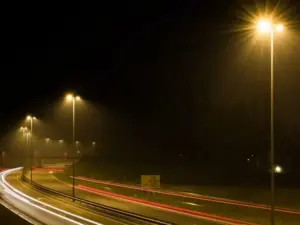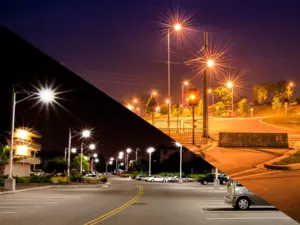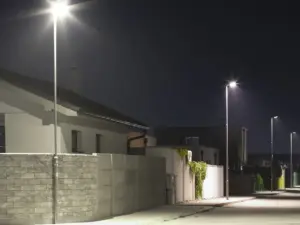Giriş:
Streetlights are an indispensable part of urban landscapes. They illuminate our roads and pathways, providing safety and visibility at night. Their warm, inviting glow is a beacon in the darkness, guiding us through the urban maze. But why are street lights yellow and not white?
The answer lies in the type of lighting technology employed and the fascinating role of sodium vapor within them. These sodium vapor lights come in two main types—High-Pressure Sodium (HPS) and Low-Pressure Sodium (LPS). They are responsible for the characteristic warm-toned illumination that graces our city streets. Continue reading for more detailed info on why street lights are orange or yellow.
Some of the Reasons Why Are Street Lights Yellow and Not White

The History Of Street Lighting
To understand why street lights are yellow and not white, we need to delve into the history of street lighting.
1. The Evolution of Street Lighting: From Gas Lamps to LEDs
In the earlier days, gas lamps were the primary source of illumination in cities. These gas lamps emitted a warm, yellowish glow due to the nature of the fuel used, often resulting in a color temperature of around 2000 to 3000 Kelvin (K). Kelvin is a unit used to measure the color temperature of light, with lower values corresponding to warmer, more yellowish light.
As technology progressed, electric incandescent lamps became the norm for street lighting. These lamps also produced a warm, yellowish light, like the gas lamps they replaced. This yellow hue was a result of the materials used in the filament of the incandescent bulbs.
2. Enter Sodium Vapor Lights: HPS and LPS
These bulbs emitted a yellowish light influenced by the materials used in their filaments. But, the coloration wasn’t a result of the technology. It was also influenced by the desire to maintain a certain level of consistency with the existing gas lamp aesthetic.
These yellow street lights owe their distinct hue to the unique behavior of sodium vapor when subjected to an electric current. There are two types of Sodium Vapor lights that are in use:
- High-Pressure Sodium (HPS) Lights: HPS lights emit a yellow glow due to the presence of sodium and mercury vapors. These gases are captured in the bulb within a high-pressure glass chamber.
- Low-Pressure Sodium (LPS) Lights: LPS lights take the sodium vapor to an extreme by employing only sodium vapor within the lamp. This results in a monochromatic yellow light emission, as other gases are absent. LPS lights have the distinction of emitting even more intense yellow-orange light.
Human Perception and Safety
The color of street lighting impacts human perception and safety. Street light colors that are warm-toned lights, such as those with a yellowish hue. They are often perceived as more comfortable and soothing to the human eye. This is because yellow street lights have longer wavelengths. They scatter less by the atmosphere compared to cooler-toned lights like blue or white. When navigating through urban environments, warm-toned lighting provides better visibility. It reduces glare and enhances contrast.
Moreover, warmer light has a lower impact on the body’s internal clock that regulates sleep-wake cycles. Exposure to cooler, bluish light at night, such as from white LEDs, can disrupt circadian rhythms and interfere with sleep patterns.
Energy Efficiency and Light Pollution
Another crucial consideration in yellow street lights is energy efficiency. Yellow or warm-toned lights tend to be more energy-efficient than cooler-toned lights. This is because warmer light requires less energy to produce the same level of brightness as cooler light. For instance, a street light emitting a yellow light can achieve the desired level of illumination using fewer lumens.
Energy efficiency also ties into the issue of light pollution. Light pollution occurs when excessive artificial light interferes with natural darkness. Warm-toned street lights are less likely to contribute to light pollution compared to cooler white lights.
Cultural and Aesthetic Factors
The choice of Street light colors can also influence cultural and aesthetic factors. Warm-toned lights might evoke a sense of nostalgia, reminiscent of the gas lamps that once adorned city streets. In certain historic neighborhoods, warm-toned lighting is preferred. It is to maintain the aesthetic character of the environment.
Cost Effectiveness
An interesting milestone in the street lighting landscape is the advent of Light-Emitting Diodes (LEDs). LEDs offer many advantages, including energy efficiency, long lifespan, and versatile color options. But, their widespread adoption was hindered by high initial costs. This factor played a role in the continued use of traditional yellow street lights, even as LED technology gained traction.
White Light VS Yellow Light

The choice between white and yellow street lights hinges on a balance between aesthetics, visibility, and energy efficiency. White LED lights offer a modern and crisp illumination that enhances color perception. But can be harsh on the human eyes. Yellow sodium vapor lights provide a warm, comfortable glow that reduces glare and maintains night vision. So, white light VS yellow light, the decision depends on a city’s goals.
LED Street Lights- Balancing Modern Technology and Human Needs

As cities continue to upgrade their street lighting infrastructure, there comes the challenge. It lies in finding the right balance between modern lighting technology and human needs. LED technology offers greater energy efficiency and versatility in color temperature. Yet, it’s essential to consider the potential impacts on human health, safety, and well-being.
More recently, the transition to more energy-efficient lighting technologies has revolutionized street lighting. LEDs, in particular, have gained prominence. It is due to their longevity, energy efficiency, and versatility. The color temperature of LED street lights can vary, ranging from very warm (around 2200 K) to cooler white (around 5000 K).
In recent years, there has been a growing awareness of the need to select appropriate color temperatures for street lighting. Some cities have opted for warmer LED lights to mitigate the negative effects of cool-toned light on human health and the environment.
Sonuç:
Why are street lights yellow and not white? The choice of this is a complex interplay of historical precedent. It also depends on human perception, safety considerations, energy efficiency, and aesthetic preferences. The advancements in lighting technology have given us the flexibility to choose from various color temperatures. Still, the yellowish hue of traditional street lights remains a common choice due to its positive impact on visibility.
It is also good for human health and energy conservation. Striking the right balance between lighting technology and the well-being of people is a challenge. Cities must address this as they continue to light up their streets for generations.